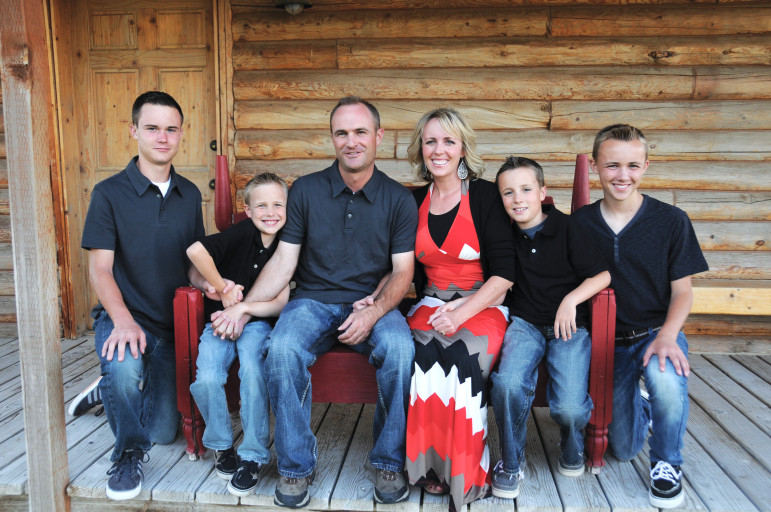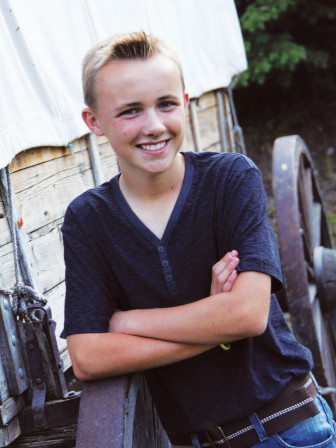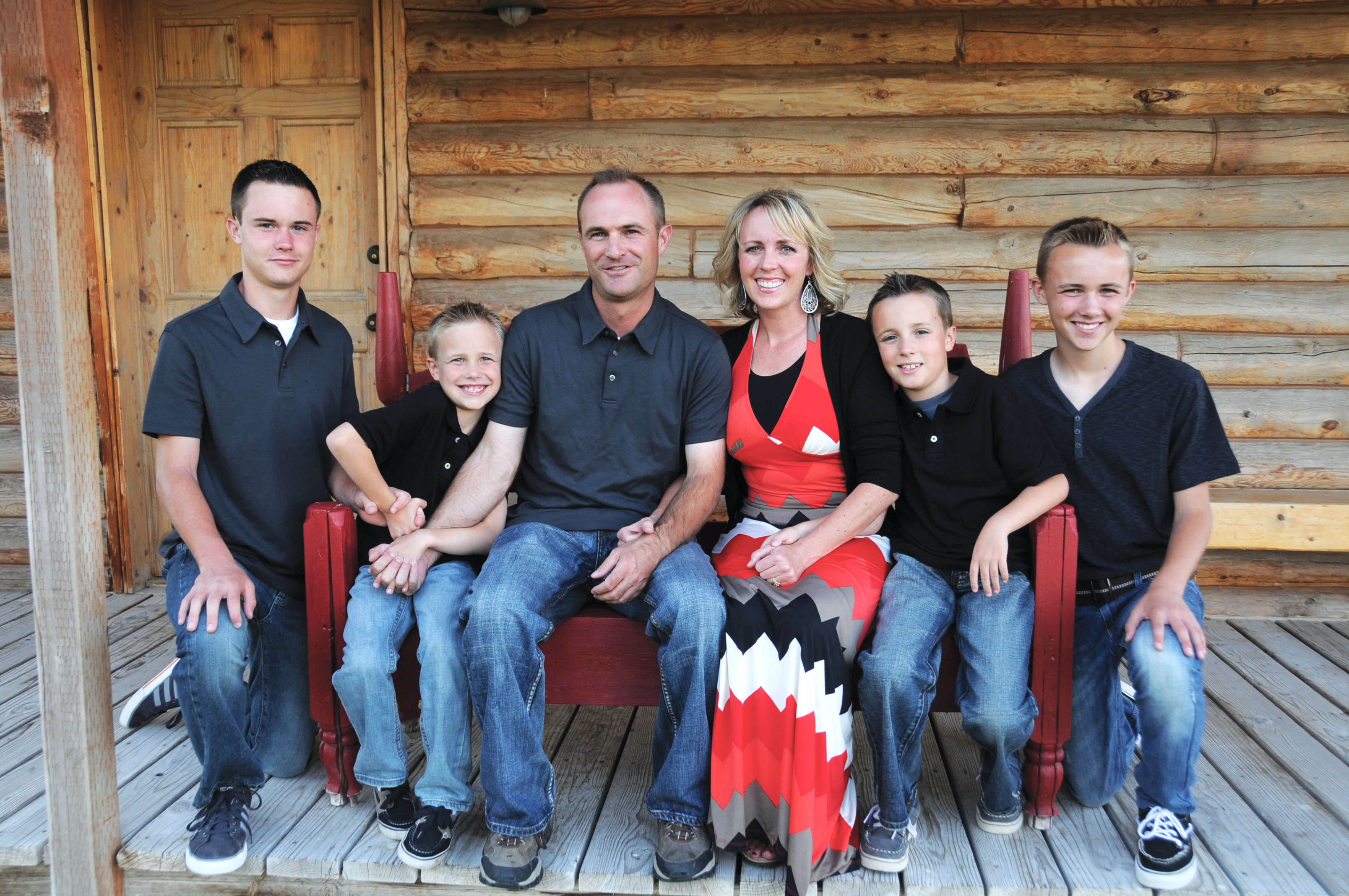
Marianne Frost
The Searle family found out about the Family Acceptance Project last year and say it’s helped them become an advocate for their brother, Zach. From left, Adam, 17; Isaac, 10; parents Greg and Christy; Luke, 11, and Zach, 15.
When Christy Searle found out her 14-year-old son Zach was gay, she thought about all the dreams she had envisioned for him. In a moment, she said, they were all gone.
“I had a moment of complete and utter despair,” she said. “For me and my religious background, and everything we’ve been taught about homosexuality, I just felt like my whole world shattered and crumbled before me.”
Searle and her husband are Mormon, and for the first two months after finding out about Zach’s sexual identity, they didn’t talk about their son’s sexuality. She told her son she loved him, and everything would be fine as long as he didn’t act on his homosexuality.
But when another mother from their family’s congregation told her about rumors that were spreading about her son at his school, Searle decided she needed to change course.
“It hit me then. I have to deal with this. I have to figure out how to, as a parent, not only to be supportive in our home, but show support to others,” Searle said. “To advocate for him.”
Searle reached out to a member at her church who connected her to Carol Lynn Pearson, a Mormon author who had married a gay man and publicly spoke about accepting gay family members. Pearson then told Searle and her husband, Greg, about the Family Acceptance Project.
The project, which started in 2002, is a national research, intervention and policy initiative to help diverse families support their LGBTQ children and decrease stigma and rejection. The project, which is based in San Francisco, has helped families support their children in the context of different cultures and faith traditions by offering direct services to families and training service providers and clergy members.

Marianne Frost
Zach Searle, 15.
Searle and her husband referred to a booklet by Family Acceptance Project specifically designed to help Mormon families with LGBTQ children. The book was titled “Supportive Families, Healthy Children: Helping Latter-day Saint Families with Lesbian, Gay, Bisexual & Transgender Children.”
“That book was transformative. It changed my whole view about homosexuality,” Searle said.
She said it changed the focus of her son’s sexuality in terms of morality to one that focused on his well-being and keeping their family together.
Zach said he saw the change in his mother too.
“She noticed how it could be such a tragedy for some people,” he said. “[The booklet] had heartbreaking stories about [rejection] — she didn’t want that kind of thing to happen to me.”
“She started to realize that it’s not a sin and God loves everyone, and that I should be able to love someone as everyone has the right to,” he said.
A researched approach
Caitlin Ryan started the Family Acceptance Project at San Francisco State University when she wanted to research how families could better engage with their LGBTQ children. She said she had noticed that families were often left out of care for LGBTQ young people.
“Families were really seen in an adversarial way and so families were intentionally kept out of services,” Ryan said.
After interviewing more than 50 families with LGBTQ children and surveying more than 220 young adults between the ages of 21 and 25, Ryan’s research, which was published in Pediatrics in 2009, found that family rejection dramatically affected the health and safety of a young person. According to her research, Ryan found that LGBTQ youth who are rejected by their families are more than eight times more likely to attempt suicide and more than three times as likely to be at risk for HIV or sexually-transmitted diseases.
“Part of the reason that we know we have so many young people at risk [for suicide and illness] and on the streets is because families haven’t been engaged earlier,” Ryan said.
About 40 percent of homeless youth identify themselves as LGBTQ, according to a 2012 report by UCLA’s Williams Institute and the True Colors Fund. The report also found that nearly 7 in 10 homeless LGBTQ youth experienced family rejection. Gay and transgender youth are also overrepresented in the juvenile justice system, according to a report by the Center for American Progress.
Instead of trying to change families’ values, the Family Acceptance Project tries to inform parents of the negative impacts and risks that “rejecting” behaviors can have on their child — such as preventing a child from hanging out with their gay friends, or pressuring a child to be more masculine or feminine. Ryan’s research identified more than 100 specific accepting or rejecting behaviors that families use toward their children.
“We’re teaching families a new language,” Ryan said. “It is a language that teaches what acceptance looks like and what rejection looks like.”
One “rejecting” behavior Searle noticed was that she was preventing her son from talking openly about his sexuality.
After seeing the evidence of rejection’s impact in Ryan’s work, she knew that she had to be 100 percent supportive of her son and advocate for him.
“It helped me to accept that his well-being is the most important thing and his safety,” she said.
Ryan said the movement works because it helps families work through the coming-out process without having to change their religious or cultural beliefs.
“It’s a very different approach. It’s empirical. It’s multicultural. And thirdly, it’s not designed to change the family – it’s really designed to change the behaviors,” Ryan said.
Including families in care
In surveys to service providers across California starting in 2003, the Family Acceptance Project found that there were no outreach programs or services to help parents and caregivers support their LGBTQ children.
“We face an uphill struggle because there’s still a perception that families can’t grow and change,” Ryan said.
In her interviews with families, Ryan said several parents wanted nothing more than to be back with their children after a child left the home. Families can often act on impulse or believe that preventing a child from expressing their gender identity and expression would protect them from victimization in society, Ryan said.
But things are beginning to change. Several organizations across the country have begun to adopt Ryan’s service model, including the Ruth Ellis Center in Detroit, which has actively included families in services starting last year.
“We think it’s absolutely critical. If we are going to end youth homelessness, we have to meet beyond the emergency needs,” said Jerry Peterson, executive director at the Ruth Ellis Center, an agency that helps runaway and homeless LGBTQ youth.
This past year, Peterson said the center has been able to reunite several families with their runaway children.
“Our approach is informed by the risk-reduction model, and we have found it to be very helpful” when families are rejecting, Peterson said.
The model is also especially important now, as children are coming out earlier in life, some as early at 6 to 8 years old, Peterson said. The Family Acceptance Project found that the average age of self-identifying as gay, lesbian or bisexual is a little over 13 years old.
In the past, youth would be old enough to live on their own when they came out to their families, Peterson said. But the “family of choice” model, where a young person leaves home to find another community, is still being promoted.
“We have to find a way for families to be able to stay together and move through this and keep their children safe,” he said.
Ellen Kahn, director of children, youth and family programs at the Human Rights Campaign, said the movement signals a paradigm shift in LGBTQ youth services.
“Many of us who were doing this LGBTQ youth work early on were LGBTQ adults who had become social workers— certainly inspired by our own experiences — you came out and when your family rejected you, that was it. That was the narrative for so long,” she said.
But, said Kahn, even parents who’ve told their children to pack their bags and leave the house can eventually change.
“I’ve seen parents transform because of Caitlin Ryan’s work,” Kahn said.
At the Ruth Ellis Center, Peterson said his organization tries not pass judgment on families who have initially rejected a child. Center employees reached out to families to include them in therapy and mental-health services.
“In my view, it’s affording them the same approach that most service providers extend to LGBTQ, or runaway or any youth who are experiencing rejection,” he said.
The Family Acceptance Project, which is currently a staff of three, has shifted from providing direct services to families to training service providers and clergy members about its evidence-based approach. It’s been more than a year since Christy Searle found out about her son, Zach. She says a lot has changed since then. She’s become an open advocate for her son along with other Mormon mothers with gay and transgender children.
She says she tries to tell people about the Family Acceptance Project, but there’s a long way to go.
“I think there’s not a lot of knowledge about it. It crosses the boundaries of religion,” Searle said. “It’s for everybody.”

























